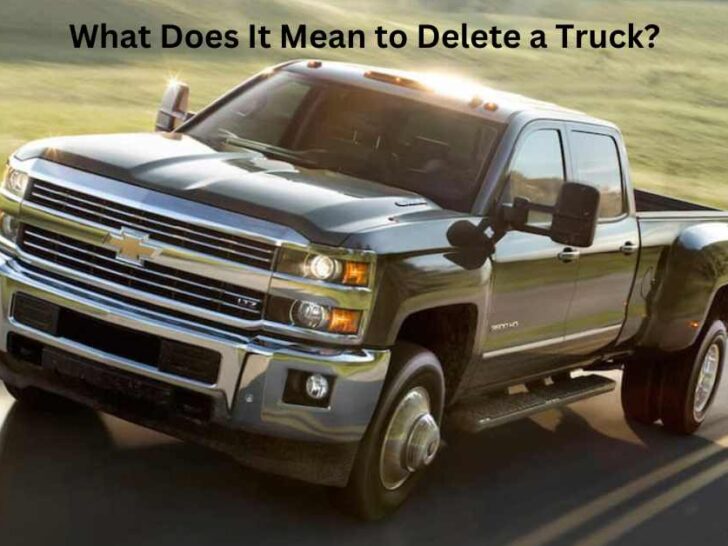Have you ever glanced at your diesel truck and wondered, “What’s the deal with deleting it?” This question often stirs up a plethora of opinions among enthusiasts and novices alike. The term “diesel delete” can denote a range of modifications and enhancements, stirring intrigue and debate within the automotive community. This blog post covers the essential aspects of “deleting” a diesel engine, exploring why one might consider it, the implications involved, and whether the advantages truly outweigh the risks.
Understanding Diesel Delete
In essence, to “delete” a diesel engine means to remove various factory-installed emissions control components, often including the diesel particulate filter (DPF), exhaust gas recirculation (EGR) system, and sometimes the selective catalytic reduction (SCR) system. These components exist primarily to reduce harmful emissions. However, they can introduce additional complexity to the vehicle and may lead many drivers to ponder their necessity.
The Motivations Behind Diesel Deletion
Why would one consider a diesel delete? The reasons can be both practical and performance-oriented. Some truck enthusiasts argue that removal of these components leads to improved engine performance, better fuel efficiency, and increased horsepower. They believe that a cleaner exhaust flow can translate into a more powerful engine, enabling better towing capabilities and overall performance. Additionally, some drivers are frustrated with the frequent maintenance and potential malfunctions that emissions systems can introduce.
A Playful Yet Serious Proposition
Ever felt that your truck’s performance could use a little boost? Now picture this: a powerful engine purring like a well-tuned symphony, unencumbered by DPFs and EGRs. Sounds appealing, right? But wait—what happens when this tantalizing notion of performance collides with reality? Herein lies the challenge: while a diesel delete might amplify power and efficiency, it comes hand-in-hand with a host of potential complications ranging from legal ramifications to hefty repair costs.
The Regulatory Landscape
A discussion on diesel delete cannot occur without addressing the legal aspects. In many regions, removing emissions components is illegal under federal and state laws. The Environmental Protection Agency (EPA) has stringent guidelines that dictate how diesel engines must operate, and deleting parts of the exhaust system can render a vehicle non-compliant. It’s crucial to consider the legal landscape before embarking on this modification journey.
The Environmental Impact
Beyond legality, let’s examine the broader environmental implications. While it’s easy to focus on performance benefits, removing emissions controls can significantly increase pollutants released into the air. Communities already grappling with air quality issues could see negative impacts as more vehicles contribute to exhaust emissions. Would you feel comfortable accelerating performance at the expense of air quality? It’s a question worth pondering.
Potential Consequences of Diesel Deletion
Alongside the aforementioned benefits and challenges, diesel deletion can lead to an array of consequences that deserve careful consideration. Void warranties, increased insurance premiums, and the potential for costly repairs are just a few of the pitfalls that diesel delete advocates might not fully consider. For instance, without DPFs and EGRs, the engine may run hotter and lead to premature wear on engine components. This could ultimately defeat the purpose of enhancing performance.
Alternative Solutions
For those fixated on performance but apprehensive about the risks associated with diesel deletes, it’s prudent to explore alternative performance enhancement methods. Techniques such as tuning the engine using performance chips or upgrading to high-flow exhaust systems can lead to substantial gains without legal repercussions. Not only can these modifications optimize performance, but they also keep your vehicle within regulatory compliance.
The Community Perspective
Engaging with the automotive community can be invaluable when deliberating a diesel delete. Forums and social media groups are rife with experiences, both positive and negative. By participating in discussions, prospective modifiers can garner insights from fellow enthusiasts and industry experts. Ultimately, it’s about making an informed decision—one that considers personal values, performance needs, and environmental responsibility.
Weighing the Decision: Is it Worth It?
The bottom line around diesel deletion? It’s not a straightforward proposition. While the allure of increased performance can be magnetic, the interplay of legal, environmental, and mechanical factors casts a complex shadow over the decision. Each driver must assess their priorities—are they willing to shoulder potential legal repercussions for heightened horsepower? And moreover, are they termed by a sense of responsibility toward the environment? Making this choice requires not just a desire for performance but a willingness to confront the ripple effects.
Conclusion: The Road Ahead
In navigating the murky waters of diesel deletion, understanding the multifaceted implications involved is paramount. So before you take the plunge into the world of diesel delete, contemplate the question: what does your truck truly need? A more significant boost in horsepower may beckon, but it’s wise to consider whether the journey toward that power is aligned with your values and awareness of the broader implications. Whatever you decide, let your choice echo your personal philosophy, ethics, and commitment to responsible driving.
